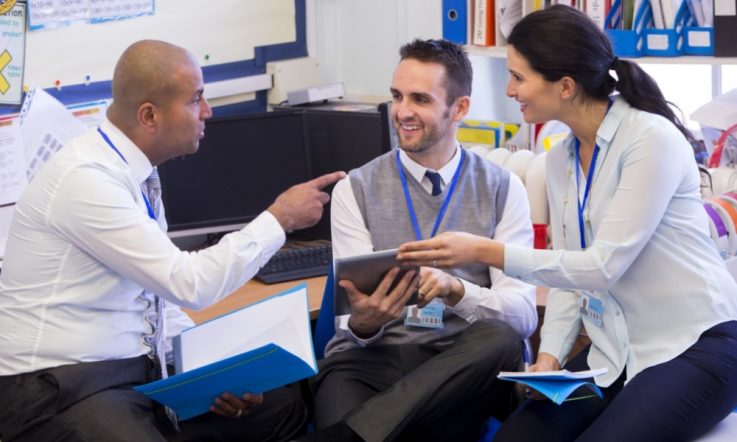Hello, and welcome to the latest episode of Teacher magazine's Teaching Methods series – I'm Danielle Meloney. I'm here today with John Fleming, Deputy Chair of the Australian Institute for Teaching and School Leadership, Deputy Principal at Haileybury College's Junior School, and Director of the Haileybury Institute. John's an advocate for the explicit instruction teaching method and has worked as a consultant in schools across Australia teaching strategies to educators. I sat down with John to see if he could share some of those strategies with Teacher readers. (*we apologise for the audio quality in a short section of this podcast).
Danielle Meloney: John Fleming, welcome back to Teacher.
John Fleming: Thank you.
DM: In your experience, what are some of the myths around explicit instruction?
JF: Okay, there are lots of definitions of explicit instruction and there are lots of different, I guess, processes associated with explicit instruction. I think the biggest myth is that it's rote learning. It's as opposite to rote learning as you can get. I think that's the biggest myth.
I think it's also often confused with direct instruction. Direct instruction is where you read from a book and you take the kids through their learning journey via the book.
That's not what I advocate, direct instruction. Explicit instruction is where you guide teachers – 'these are the key skills, this is the template that you follow to impart those key skills to kids in a way that the kids are involved in their learning, understand how they are being taught, and are able to reflect on their learning'.
DM: So, last year you spoke to us generally about what explicit instruction is. Today I wanted to get more into the nuts and bolts of the teaching method and ask you about actual strategies. Could you give Teacher readers a few specific strategies that they could effectively adopt to use explicit instruction in the classroom?
JF: Yeah. Most approaches to explicit instruction use the 'I do, We do, You do' model. And I really like that model. Because what it does is introduce a filter into the classroom that determines 'are kids ready to move on with this, or do I need to do more work around this?'
So traditionally we've done the ‘I do', where the teacher says ‘here's what we are learning today' and goes through that and gone straight to the ‘you do' – ‘Off you go kids, now go do that.' I just think we've got better at teaching because we need to find out, do the kids actually get this? So the ‘we do', I think, is a really effective filter where you check for understanding. And then the kids who get it, fine, you move on and do the ‘you do'. I need to do some more work with these kids here. And we've found at Haileybury that the kids are very, very good at determining ‘do I need more help, or am I ready to go?' But we've also found they like the fact that they can determine where they go [and say] ‘I need more help'. And it's okay to say that, because I think in a lot of classrooms kids don't have a vehicle or an opportunity to say ‘look I'm not sure'. Or [they] feel uncomfortable saying that.
So I think the ‘I do, We do, You do' is a really effective way ... because what it does is it hones teachers' ability to focus on the I do – 'I need to explain this really clearly because I want all the kids to get it'. I think they start thinking about their delivery of curriculum in a more effective way.
DM: In terms of strategies now, could you elaborate on strategies for leaders at a whole school level?
JF: Leadership for me is about providing a clear direction for the school. What I find in a lot of schools, I believe, is that clear direction is not actually there. Each year the direction changes, there's new goals, new things.
When I work with schools across Australia what we try and do is develop an ongoing direction that is modified over time. But the ongoing direction is ‘Okay, we are doing explicit instruction, we are doing I do, We do, You do. We are going to train our teachers up in that, we are going to provide support, documentation, professional learning, resources – that's our goal, and then unpacking it step-by-step for teachers. And it's not ‘we're going to change this next year', we're going to be doing it this year, next year, the year after.
Singapore's a good example. They're an explicit instruction system. So, all their teachers are trained in explicit instruction, but then each year they add something to it. So their focus this year is cooperative learning within explicit instruction. So I think that's a really good example of what I'm saying. [In Singapore they use] explicit instruction year after year, but [they] enhance your ability to deliver on an ongoing basis. I think that's what schools should do.
DM: You just mentioned Singapore, it caught my interest. Are you currently working with any schools in Singapore?
JF: We follow what all nations do at Haileybury. So, for instance, Singapore is the number one nation in the world for maths so we've looked at what they're doing. They have one process called the Bar Model Method, which is really (we've introduced it here), it really helps kids [develop] problem solving skills in maths. It's not our whole problem solving process, it's just one strategy that kids can use, but it's an explicit instruction strategy and it's really effective. And if they're the number one nation in the world, let's find out what they are doing and see what they do that can fit into us.
We have used the Bar Model Method, and we've trained all our teachers up exactly like that. We've introduced them to it, we've got a teacher here who has become an expert in it. He has gone around and modelled for our teachers, he has produced resource materials for our teachers, in terms of lesson plans from prep all the way through. So teachers go ... ‘here's a lesson plan, I've seen Julian do this, I've been to a PD'. So we support our teachers in their development rather than just saying 'go and do the Bar Model Method', 'Well, what's that?' ... And again, that's what I think school development is about.
DM: You're saying you support all of your teachers with that method, that would include both primary and secondary I would assume?
JF: When I consult I work with primary and secondary, K-12, and the model is very similar. Explicit instruction evolves. In secondary school I ask teachers these four questions: Are you giving the kids the context for their learning? Whether it be Year 9 maths, whether it be Year 11 science. Are you giving them a context of why they are learning this? Number two, are you unpacking it step-by-step so that the kids say ‘okay, we get this'? Are you checking for understanding? ... And, are you differentiating the learning for the kids according to their ability?
If the answer to those four things is 'yes', you're doing explicit instruction.
... ‘I do, We do, You do' might take place over a unit of work, rather than a single class like in a primary school. So it is different in secondary, and it evolves and it caters for the fact that the kids are developing and are able to take more responsibility for their learning. But still, the basic premise is we are breaking this up step-by-step so that you can understand it, and not only understand it, know why we are learning this.
And this is where problem solving comes in. We would like all our teachers to pose a problem for the kids so the kids see why they are learning this. And then we have what's called plough back at the end of the lessons: ‘Okay kids, can you answer that problem now?' , ‘Yeah, yeah we know what to do now.'
DM: John Fleming, thanking for taking the time to speak to Teacher today.
JF: A pleasure, thank you Danielle.
To listen to more Teacher podcasts and to access our articles, videos and infographics - visit www.teachermagazine.com.au, or join our community on social media via Facebook and Twitter.
- Make sure you don't miss a Teacher podcast, subscribe for free by visiting acer.ac/teacheritunes or www.soundcloud.com/teacher-ACER.
Are you using explicit instruction in your classroom? John Fleming suggests asking yourself these questions to double check:
- Are you giving kids the context for their learning?
- Are you unpacking the process step-by-step?
- Are you checking for understanding?
- Are you differentiating the learning for the students according to their ability?



